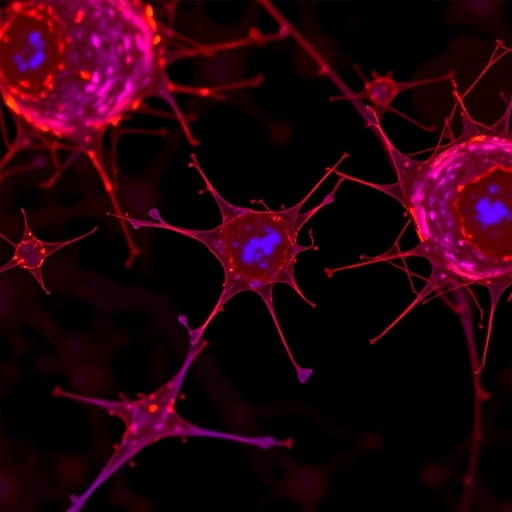In a groundbreaking study published in Cell Death Discovery, researchers have unraveled the complex dynamics within the melanoma tumor microenvironment that not only enhance our understanding of cancer progression but also highlight a paradoxical cellular state that could redefine therapeutic strategies. The study, led by Chiheb et al., delves deep into how the acidic milieu characteristic of melanoma tumors fosters a unique subpopulation of cancer cells displaying features of cellular senescence alongside active migratory capabilities, driving the metastatic cascade. This paradoxical “senescence-like but migratory-active” phenotype challenges traditional views on senescence as merely a tumor-suppressive state and unpacks its dual role in cancer biology.
Melanoma, a highly aggressive skin cancer, is notorious for its ability to metastasize rapidly, largely dictating poor patient prognosis. One of the hallmarks of tumor microenvironments, including melanoma, is acidity, stemming from altered metabolism such as aerobic glycolysis and hypoxic conditions. Chiheb and colleagues meticulously investigated how this acidic environment influences melanoma cell populations to adapt or evolve a phenotype conducive to invasion and metastasis. Their work reveals that precisely this acidic niche selects for a subpopulation exhibiting features reminiscent of cellular senescence—a stable cell cycle arrest traditionally viewed as a protective barrier against malignant transformation—but one that defies expectations by retaining robust migratory functionality.
The concept that senescent cells, typically characterized by irreversible growth arrest and secretion of pro-inflammatory factors, can also evade this growth arrest or adopt traits enabling migration and invasion places this study at the frontier of cancer biology research. Senescence has long been associated with tumor suppression, acting as a natural brake on cellular proliferation. However, this study articulates that the melanoma microenvironment’s acidity dynamically secures a cell population that, while displaying senescence markers like beta-galactosidase expression and altered morphology, paradoxically gains enhanced motility. This dual identity essentially empowers these cells to both withstand environmental stresses and contribute to metastatic dissemination.
Using sophisticated in vitro modeling alongside in vivo validation, the team exposed melanoma cells to acidic conditions mimicking the tumor microenvironment. Intriguingly, the cells surviving prolonged acidic stress displayed a senescent-like phenotype, verified by increased senescence-associated beta-galactosidase staining and upregulation of cell cycle inhibitors such as p21 and p16. Surprisingly, these same cells exhibited elevated expression of migration-related molecules including matrix metalloproteinases and integrins, as well as cytoskeletal rearrangements indicative of migratory capacity. Live cell imaging confirmed their active motility, effectively overturning the dogma that senescent cells are biologically inert.
Further molecular analyses uncovered that this migratory-senescent subpopulation harnesses distinct signaling pathways that regulate adhesion dynamics and cytoskeletal plasticity. Notably, pathways involving Rho GTPases and focal adhesion kinase (FAK) were modulated in response to acidic stress, facilitating cell movement despite the cell cycle arrest. This suggests a tightly coupled regulatory circuitry enabling melanoma cells to survive in an extracellularly hostile environment while exploiting the senescence-like state as a springboard for invasion. Such findings underscore the plastic nature of tumor cells, which are adept at reprogramming intrinsic programs to meet extrinsic challenges.
The implications of this dualistic senescence-migration phenotype are profound. Therapeutically, strategies aimed at eliminating or reversing senescence-related growth arrest in tumors could inadvertently potentiate metastasis by activating the migratory machinery of these subpopulations. Conversely, anti-metastatic therapies might need to consider targeting these senescence-associated migratory pathways to effectively curb disease progression. The study cautions against simplistic interpretations of senescence in cancer treatment paradigms and calls for a deeper understanding of the microenvironmental contextual factors that guide tumor cell behavior.
This discovery also aligns with accumulating evidence that tumor microenvironment acidity is a critical determinant not just of metabolism but also of cell fate decisions, invasiveness, and resistance to therapy. By replicating and studying these acidic conditions in vitro, the researchers have created a valuable model to dissect the emergent biological properties of tumor cells and to identify potential molecular targets that are environmentally contextual. This model can accelerate preclinical testing of agents designed to disrupt these metastatic subpopulations.
The research further expands the conceptual framework of cancer cell heterogeneity. It highlights how non-genetic factors, like microenvironmental acidity, orchestrate phenotypic diversification beyond mutations, fostering specialized subpopulations that collectively enable tumor survival and spread. It challenges the conventional narrative that senescence universally equates to tumor suppression and opens avenues toward identifying biomarkers that capture this senescence-migratory hybrid state.
Clinically, these insights offer potential markers for metastatic risk stratification and therapeutic resistance. Patients harboring melanomas enriched in acidic microenvironments may be predisposed to develop aggressive disease driven by these senescent-like migratory cells. Monitoring markers of both senescence and migration may aid in early detection of metastatic potential and could inform more precise therapeutic regimens tailored to disrupt this cell subset preferentially.
Moreover, the work touches on the interplay between acidic stress and cell signaling networks that maintain a delicate balance between dormancy, invasion, and proliferation. Future research inspired by these findings may uncover additional microenvironmental cues and intracellular circuits governing this balance, offering a holistic perspective on cancer progression grounded in tumor ecology.
In sum, Chiheb et al.’s study compellingly redefines cellular senescence within melanoma biology. Their demonstration that an acidic melanoma microenvironment selects for a senescent-like subpopulation with active migratory properties upends preconceived notions and illuminates new paths for tackling metastasis. This nuanced understanding of tumor cell plasticity and microenvironment-driven evolution sets the stage for innovative interventions that could transform outcomes for melanoma patients grappling with metastatic disease.
As the field advances, integrating biochemical, molecular, and ecological insights from such rigorous research will be crucial to decrypt the complexities of tumor heterogeneity and metastasis. It is only with this multifaceted approach that we can aspire to develop therapies not just arresting tumor growth, but preventing cancer’s deadliest feature—its relentless spread. This seminal work thus stands as a beacon, guiding scientists towards more effective ways to outsmart one of humanity’s most formidable malignancies.
Subject of Research: Melanoma tumor microenvironment and cellular senescence in metastatic progression
Article Title: Acidic melanoma microenvironment selects for a senescence-like but also migratory-active subpopulation driving metastatic disease
Article References:
Chiheb, C., Fischer, S., El Ahmad, Z. et al. Acidic melanoma microenvironment selects for a senescence-like but also migratory-active subpopulation driving metastatic disease. Cell Death Discov. 11, 469 (2025). https://doi.org/10.1038/s41420-025-02806-0
Image Credits: AI Generated
DOI: https://doi.org/10.1038/s41420-025-02806-0
Tags: acidic tumor microenvironmentaerobic glycolysis in melanomacancer cell phenotypes and behaviorcancer progression and treatmentcellular senescence in cancerhypoxic conditions and cancermelanoma metastasis mechanismsmelanoma research breakthroughsmigratory melanoma cellsparadoxical cellular states in tumorstherapeutic strategies for melanomatumor-suppressive state of senescence





